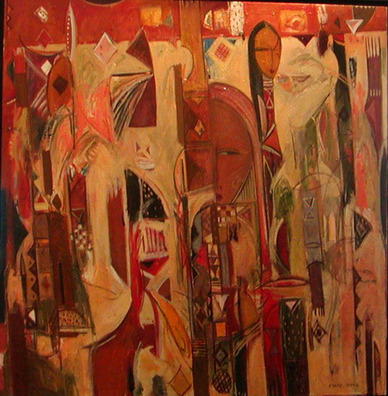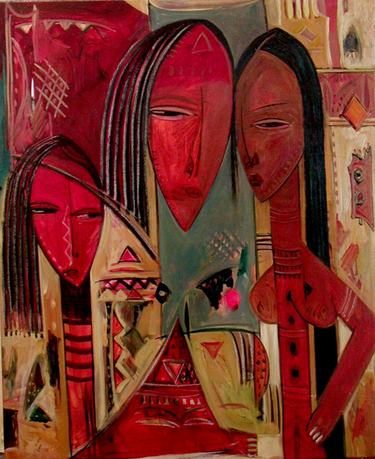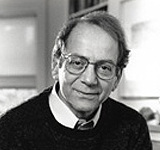Tadias Magazine
By Donald N. Levine
Published: Thursday, January 8, 2009
New York (Tadias) – Featured in exhibitions in two prestigious French galleries in Autumn 2008, Galerie Alternance in the north and Galerie Cabotse in Paris, the work of Fikru Gebre Mariam has reached new levels of both aesthetic power and public recognition. The moment is ripe for looking back at Fikru’s oeuvre and taking a fresh look at his artistic development.
Inspired to pursue an artistic career after winning an award at age 13 at the International Children’s Painting Exhibition in Beijing, Fikru began formal study at the Addis Ababa School of Fine Arts, founded a half-century ago by the distinguished artist Ale Felege Selam, who introduced modern methods of teaching drawing and painting, which he had studied at the School of the Art Institute of Chicago in the 1950s. There he became a protégé of instructor Tadesse Mesfin, who not only taught him painterly skills but gave him a graphic theme which he would embrace, struggle with, and grow through, ever since. The motif was a variant of a genre of contemporary Ethiopian painting sometimes glossed as “2 women,” a phrase used to represent women doing everyday tasks like spinning and making pottery, as shown in one of his paintings. Although some Ethiopian artists often dismiss their works in this genre as mere touristic products, not expressive of their true selves, others have turned it into a serious genre. In Fikru’s hands, it became a vehicle for one epiphany after another. He has gone from depictions of groups of women standing, to more abstract representations, often with masks, to purely abstract creations.
At each phase similar qualities strike the viewer. They convey a blend of rich hues, emotional intensity, immediacy of impact, and a touch of austerity. If asked to compare them to European artists, I would say that Fikru’s compositions offer a blend of Modigliani figures in a Giacomettian “Still Ladies” stance presented with Braquean geometric abstraction. In a conversation with the artist, Fikru let me know that Braque was indeed his favorite artist. Even so, there is no mistaking the deeply Ethiopian flavor of these paintings. They display hints of Ethiopian miniatures and church paintings. They are imbued with African earth tones. They use the colored garments of Harari women. They capture the somber mood of much Ethiopian life.

The Dream – 120×120 cm – Oil on canvas – 2004. Upcoming
shows – 2007: solo exhibition National Museum, Addis Ababa,
Ethiopia. 2007: May 1-30: solo exhibition, Galerie François 1er,
Aubigny sur Nère (18700), France. Opening on May 5th at 5pm.
2008: summer: Galerie Alternance Guy Lignier, Hardelot, France.

Blue dream 100×81 cm Oil on canvas 2004. Painting by Fikru
G/Mariam (Addis Ababa & Paris).
The world of Ethiopian painters is, like much else about contemporary Ethiopian life, divided between those who have remained at home and attempted to be true to Ethiopian realities, and those who have emigrated and whose offspring evince a passion to emulate Western styles to a high degree. With studios in Paris and Addis Ababa, where he spends half a year each, Fikru savors all he can of both worlds. He insists that it is essential for his art that he remains close to his Ethiopian roots–and indeed has continued to live in his father’s gibbi until now. At the same time, Fikru finds it no less essential to spend half of each year abroad. As he wrote me, “I believe the freedom of being out of Ethiopia has amazing value in my life and work. Both in Europe and the U.S., especially in Paris . . .visiting museums and art galleries bring dramatic important changes in my work. It is like seeing yourself in the big mirror, even if you think you know yourself.”
Seriousness but not somberness is immediately evident when one meets the artist–a rugged, good-looking, almost athletic Ethiopian male in his mid-thirties. He could be, and really is, an assiduous businessman. He works without stop, producing a seemingly endless flow of polished products. His studios in both cities are packed with canvasses like rush-hour traffic. This enables him to live fairly inexpensively and yet maintain a wealth of paintings for sale, in contrast to Ethiopian artists in the Diaspora who often find it difficult to make ends meet.
Even so, it is not mainly a commercial motive that drives his prolific output. His social conscience remains alive and well; his many awards include posters against AIDS and for Family Planning. Beyond that, Fikru’s being patently manifests his relation to art as a vocation in the deeper sense. It offers him a constant challenge to let his spirit grow. This is one reason why I believe his work has such an impact on viewers. It certainly had on me.
That said, the exceptional value of the art of Fikru Gebre Mariam may lie in its capacity to mediate Ethiopian and Western worlds, yet at a level that marks him as one of Ethiopia’s most acclaimed international painters.
Learn more about Fikru Gebre Mariam at www.fikru.fr.
About the Author:

Donald N. Levine is the Peter B. Ritzma Professor Emeritus of Sociology at the University of Chicago. “He is the author of many books, chapters and articles on Ethiopia and has had direct involvement in Ethiopian affairs since the 1960s. His works on Ethiopia include: Wax and Gold: Tradition and Innovation in Ethiopian Culture (1965), now reprinted by Tsehai Publishers and Greater Ethiopia: The Evolution of a Multiethnic Society (1974), a second edition of which, with a new preface was published, in 2001. Other publications include Visions of the Sociological Tradition (1995) and, most recently, Powers of the Mind: The Reinvention of Liberal Learning.” (The Ethiopian American.). Professor Levine’s research and teaching interests focus on classical social theory, modernization theory, Ethiopian studies, conflict theory and aikido, and philosophies of liberal education.
The more I read about Fikru and others the more interested I am with Tadesse Mesfin. Do you have papers, available ars and a beach place? CC
The more I read about Fikru and others the more interested I am with Tadesse Mesfin. Do you have papers, available art and where he is exhibiting this year (2009)? CC
you are wonderful ,
hello dear fikru, how are you today? i’m proud of you. i think you got a wonderful place in Paris. i wish to see your new great works.
all the best
artist friend mate